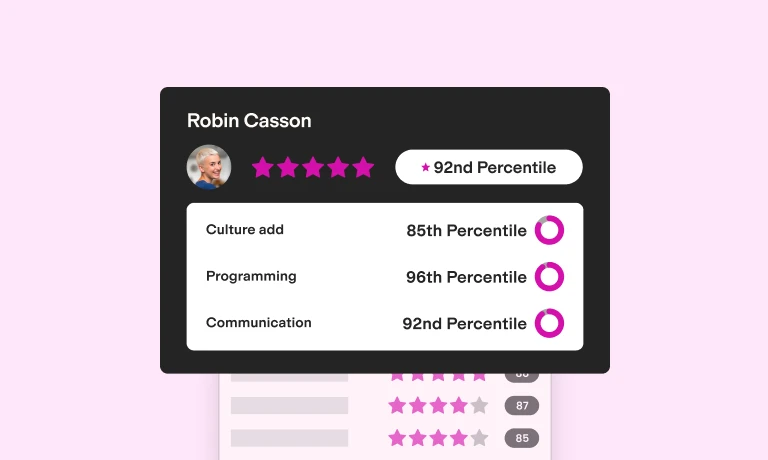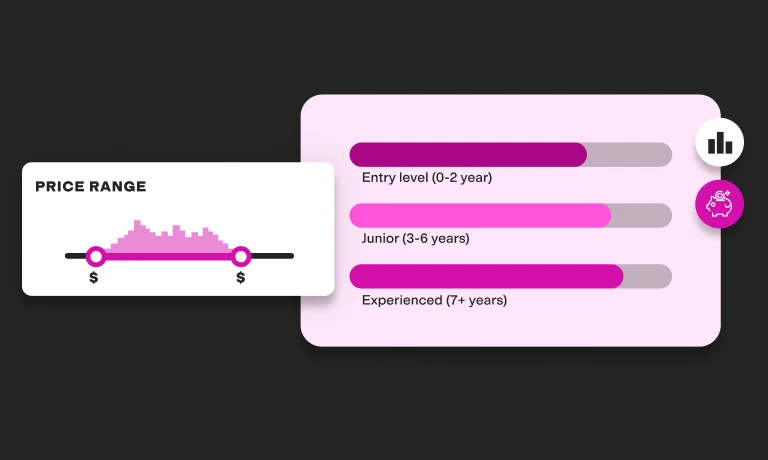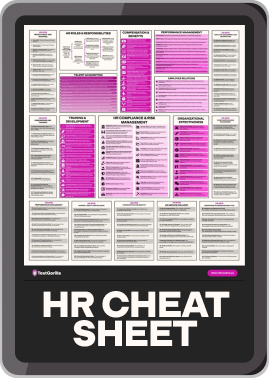Proficient vs. fluent: How to choose the right language skill for the job
When hiring for roles that require strong communication, deciding if a candidate must be "proficient" or "fluent" in a certain language might sound simple. But these terms mean very different things. Use them imprecisely, and you could end up screening out great candidates – or bringing on someone who isn’t the right fit.
Evaluating language proficiency vs. fluency helps you write better job descriptions, align your hiring team, and set clear expectations for everyone. It also makes interviews smoother and onboarding more successful.
Let’s break down what these terms mean, how to assess them, and when each one matters most.
What does "proficient" mean?
Someone proficient in a foreign language is good at reading, writing, speaking, and listening in that language – but they might not sound exactly like a native speaker.
Think of someone who’s proficient as being able to get the job done effectively in the target language, even if they need a moment to think sometimes.
A proficient language user can:
Write emails and reports with few mistakes
Understand instructions and explanations
Join meetings and contribute meaningfully
Read work documents without needing translations
Use proper work-related vocabulary
An example of someone who’s proficient is Marta: She can write detailed project updates in English for your team, follow along in meetings, and read technical manuals. When a client emails with questions, she responds clearly and professionally. She might occasionally need to look up an unusual term, but it doesn't slow her down much.
What does "fluent" mean?
A fluent speaker can talk smoothly and naturally without stopping to think or search for words. A fluent person sounds more like someone using their native language – they're quick, comfortable, and confident when speaking.
Fluency is mostly about:
Speaking smoothly without lots of "umm" and "uhh" pauses
Having real conversations without planning what to say
Thinking in the target language instead of translating in their head
Switching topics easily without getting stuck
Understanding fast speech and different accents
While a proficient person might need to pause and think sometimes, a fluent speaker keeps talking – similar to how people speak when using their first language.
An example of someone fluent in Mandarin is Carlos: When Chinese clients call unexpectedly, he jumps on the phone and handles the conversation easily. He jokes with them, discusses complex issues, and builds rapport naturally.
He might make grammar mistakes, but the conversation flows so well that nobody notices or cares that much. Unlike a language learner who may still rely on rehearsed phrases, Carlos can adapt his speech naturally to different situations.
The best insights on HR and recruitment, delivered to your inbox.
Biweekly updates. No spam. Unsubscribe any time.
Proficient vs. fluent: Key differences in hiring
The terms proficient and fluent are often used interchangeably, but they’re not interchangeable.
Consider what Eva Sandoval, an Italian-American writer, wrote in a BBC article:
“A ‘heritage speaker’ of Italian, I’d been living in Italy for two years when I overheard a receptionist refer [sic] to me as ‘that foreigner who doesn’t speak Italian’. I was… forced to acknowledge that while I had grown up speaking Italian at home and was fluent, I was not by any means proficient.”
The article also mentions that “while fluency may denote a degree of proficiency, it does not automatically imply accuracy – the ability to produce grammatically correct sentences.”
So, when it comes to hiring, the distinction between these terms matters. Choosing the right one helps you set clear expectations and avoid mismatches between the role and the candidate's actual language levels.
Here’s how the two differ in a hiring context:
1. Scope of skills
Proficiency covers the full spectrum – reading, writing, listening, and speaking. It’s about structured communication across familiar or professional contexts.
Fluency, on the other hand, focuses on verbal ease – primarily speaking and listening. It reflects how naturally someone can carry on a conversation, especially under time pressure.
2. Measurement methods
Levels of proficiency are typically measured through standardized talent assessments like the ACTFL or CEFR. These tests evaluate candidates’ language levels and skills across tasks.
The Common European Framework of Reference for Languages (CEFR) is the go-to standard. It breaks down language proficiency into six levels, from beginner (A1) to near native language user (C2):
Proficiency level | CEFR label | What it means |
A1 | Beginner | Understands basic words and familiar expressions |
Elementary | Can handle simple communication on familiar topics, but may rely on memorized phrases and have a limited vocabulary | |
Intermediate level | Manages everyday tasks and basic work conversations | |
Upper-intermediate | Handles more complex topics, workplace interaction, and email writing | |
Advanced | Reads and writes fluently, and uses a wide range of vocabulary accurately | |
Mastery | Speaks and understands like native speakers, including nuance and tone |
Fluency level is harder to measure on paper. It often becomes clear during interviews or casual conversations when you see how someone performs in real-time dialogue.
As Hayden Cohen, CEO at Near, implies, what works best for assessing fluency is talking to candidates:
"The baseline thing we do is video interviews and live calls. There’s no better litmus test than natural conversation…
“During a video interview, check if the candidate is reading off a paper or frequently looking at the screen. If they’ve practiced phrases but struggle to speak naturally, they might have trouble thinking on their feet during real conversations."
3. Use in the workplace
Proficient speakers shine in roles that require written communication, document handling, or structured meetings. They’re prepared, detail-oriented, and effective with time to think.
Fluent speakers thrive where quick thinking and spontaneous speech are key – like live sales calls, support lines, or cross-cultural negotiations.
In short, proficiency is about reliability across tasks. Fluency is about speed and comfort in live interactions. They often overlap – but they aren’t the same. A worker can be fluent (smooth and confident) yet lack grammatical accuracy or a wide vocabulary. Similarly, an employee who’s proficient may write or read well but hesitate when speaking.
Some roles need both – but many will require one more than the other.
This simple chart shows how someone might have different combinations:
| High Proficiency | Lower Proficiency |
High Fluency | Speaks smoothly AND accurately; handles both casual and formal communication well | Speaks quickly and confidently but makes recurring technical errors |
Lower Fluency | Speaks accurately but with hesitation; is stronger in writing than in spontaneous speech | Still developing both technical accuracy and conversational comfort |
Importance of language proficiency and fluency in the hiring process
Getting clear on proficient vs. fluent isn't just about semantics – this directly impacts hiring success. Here’s how:
Matches skills to actual job tasks
Different positions require different language capabilities. For instance:
A content translator needs writing proficiency but might never speak the language
An international sales rep needs fluency for calls and meetings
A research analyst needs reading proficiency to review foreign documents
Call center staff members need listening and speaking fluency
Ask yourself questions like: "Does this role need someone who can write perfect emails, or someone who can have smooth phone conversations with international clients?" This will help you look for candidates with the appropriate language skills.
Saves time with better applicants
When your job post says "someone fluent in Spanish is needed for customer calls," people who can read and write Spanish but get nervous speaking are less likely to apply. When you ask for "proficiency in German for technical documentation," people who speak smoothly but make writing errors will think twice. This gives you a better applicant pool from the start.
Sets appropriate expectations
When everyone shares the same definition of language requirements, you avoid misalignment between hiring team members and candidates. This reduces situations where a new hire struggles with unexpected language demands.
Helps with targeted screening
Once you know exactly what you need, you can test for language proficiency or fluency properly:
Need proficiency? Ask candidates to write an email or summarize a document, or, better yet, take a language proficiency test.
Need fluency? Have a spontaneous conversation or role-play a customer call.
Consider this example: A company hired a fluent Spanish speaker for a support role that involved mostly email. While they spoke well, their writing had frequent errors. Clients got confused, and the team realized they should’ve screened for writing proficiency – not just fluency.
Test language skills properly with TestGorilla
Now that you understand the difference between proficient and fluent, how do you check if candidates have these skills? Asking "Are you fluent in Spanish?" on applications isn't reliable – candidates often overestimate their abilities.
TestGorilla's language proficiency tests take the guesswork out. Our tests:
Enable you to screen candidates before interviews so you talk only to qualified people
Check both technical skills (grammar, vocabulary, reading) and practical usage
Show you exactly where candidates fall across different levels of language proficiency
Test for the specific language skills your job needs
Give you the option to include custom questions that elicit video responses – great for gauging fluency
By testing early in the hiring process, you reduce bias, speed up screening, and focus only on candidates who are ready to deliver.
Explore our language proficiency tests to get started – or get a demo today.
You've scrolled this far
Why not try TestGorilla for free, and see what happens when you put skills first.




















